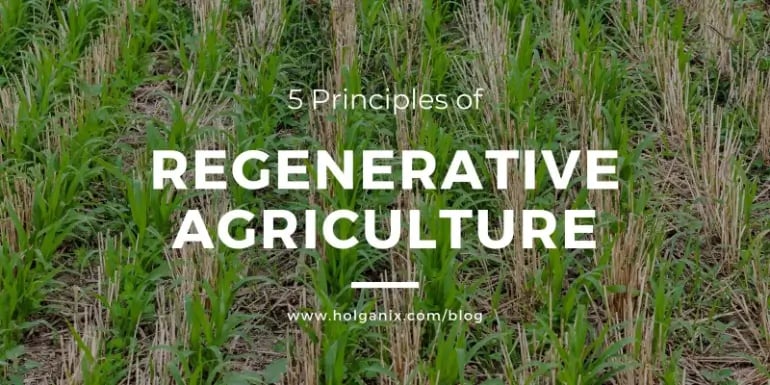 What is regenerative agriculture? Regenerative agriculture describes farming and grazing practices that focus on regenerating topsoil. This allows farmers to maintain crop yields, improve water retention, improve plant nutrient uptake, increase farm profitability, and support bio-sequestration, among other benefits.
What is regenerative agriculture? Regenerative agriculture describes farming and grazing practices that focus on regenerating topsoil. This allows farmers to maintain crop yields, improve water retention, improve plant nutrient uptake, increase farm profitability, and support bio-sequestration, among other benefits.
The backbone of regenerative agriculture is a focus on strengthening the health and vitality of farm soil. A key point about regenerative agriculture is that it does not harm the land, in fact, quite the opposite! Regenerative agriculture IMPROVES the land by using technologies to build soil health, such as compost, recycling waste, and limited-to-no-tillage, among other practices.
In this blog, we discuss the 5 principles of regenerative agriculture:
- Maintaining Soil Armor
- Minimizing Soil Disturbance
- Maintaining Continual Living Plant Roots
- Adding Planting Diversity
- Integrating Livestock
Building Soil Armor
Keeping your soil covered is critical to maintaining and building soil health. Specifically, it reduces runoff and soil loss, conserves soil moisture, increases organic matter, and improves soil structure. Soil armor can be broken down into two categories: passive armor, which is the crop residue that remains on the soil following harvest, or active armor, which consists of growing cover crops.
According to the USDA Natural Resources Conservation Service of Pennsylvania, “50% soil armor is considered acceptable, but higher levels provide even more soil erosion protection, help conserve soil moisture and reduce soil temperature during the summer months, and help protect and feed soil organisms.”
When it comes to crop residue, some growers experience problems with heavy residues, especially corn stalks. Here are four techniques to manage heavy corn stalks:
- Apply a microbial with lignin degrading fungi and bacteria after harvest to speed crop decomposition. According to the USDA, “Having a healthy biologically active soil is key to the breakdown of residues... fungi specialize in breaking down lignin so high-fungal populations found in long-term no-till soils will be beneficial.” Adding lignin degrading fungi via a microbial will boost populations in the soil and hasten crop decomposition.
- Let corn stalks stand after harvest.
- Plant cover crops into the residue. According to the USDA, “The drill cuts up the crop residue in smaller pieces and increased biological activity and microclimate created by the cover crop favors residue decomposition.”
- Use planter attachments to move residue from the row.
Minimizing Soil disturbances
According to retired USDA Agricultural Research Service (ARS) soil scientist Don Reicosky, “Soil is lost not because we farm, it’s lost because of how we farm.”
Practicing no-till farming or strip-till farming allows farmers to minimize soil disturbance, ultimately increasing soil health.
According to the USDA, “Fields managed using no-till farming for multiple years generally have a higher water holding capacity.” This is crucial in drought-prone areas where water shortages are tied to crop loss.
Additionally, adopting no or strip-till farming reduces erosion and soil compaction while increasing soil biological activity and soil organic matter. Soil organic matter is one of the most crucial factors for productive soils, and productive soils could lead to increased yields.
Maintaining Continual Living Plant Roots
According to No-Till Farmer, “When left to her own devices, Mother Nature makes sure there is something living and growing in the soil at all times.”
“In a traditional corn-soybean rotation, there are only active roots in the soil about 32% of the year, leaving the root zone a desert for the remaining 68% of the time. That leaves hungry soil microbes high and dry and organic matter in short supply.” Those roots, and especially the soil microbes they work with, are critical to cycling nitrogen and phosphorus.
In fact, scientific literature states that over 50% of fertilizer is lost because it becomes tied in the soil, washes off, erodes, or becomes volatilized in the air. “The waste is outrageous. And the thing is, soil microbes improve fertilizer efficiency,” explains Dave Stark, Ph.D., and President of Agriculture at Holganix. “Biologically healthy soils create greater corn yields per unit of nitrogen input.”
Todd Loecher of The Van Trump Report said it best, “At the heart of regenerative agriculture is the understanding that the soil must be fed first and foremost, and that is where you start, by putting life back into your soil. You must first understand that your soil is not lacking in nutrients but rather the biology to make those nutrients available.”
Leveraging cover crops and using microbials that stimulate a more robust root system, in all crop types, gives farmers a way to cycle more of the nutrients.
Adding Plant Diversity
“Plants play an active role in seeking nutrients, defending themselves from pests and disease, responding to invasive plants, and stimulating soil microbial activity,” explains soil scientist Ray Ward of Ward Laboratories.
When farmers promote plant diversity, they “promote an environment in which plants interact, soil microbial activity can be stimulated by plants, and farmers will benefit in several ways. They can reduce input costs because soil microbes can provide more nutrients and more water to plant roots than plants are able to obtain on their own.”
To account for plant diversity, farmers should grow a balance “of warm-season grasses and cool-season grasses, warm-season broadleaves, and cool-season broadleaves, that encompass major plant types that naturally grow in uncultivated regions.”
integrating Livestock
Regenerative agriculture does not require animals, but livestock contributes a vital service by returning nutrients in the form of manure back to the land when grazing. This process improves soil health by promoting organic matter, activating soil microbial communities, and increasing nutrient cycling.
How do Regenerative Agriculture and Holganix Bio 800+ Agriculture Fit Together?
Regenerative agricultural practices like composting, cover crops, and no-to-low-till, leave food sources for soil microbes in the soil. By providing food sources for microbes, regenerative agriculture strengthens soil microbes.
Holganix Bio 800+ Agriculture harnesses the power of over 800 species of soil microbes to recharge soils, ultimately leading to fertilizer reductions, improved yield, root growth, and crop resilience against stress.
When you combine regenerative agriculture practices (which provide microbe food sources) and the diverse consortium of microbes in Holganix Bio 800+ Agriculture, results from both can increase.
Dig Deeper into Soil: Download Our Soil Science EBook
Digging Soil Science 101: Beginners Guide to Understanding the Soil Food Web
We know regenerative agriculture and long-term sustainability of farmland hinges on the health of soils. But how does soil work? And what does healthy soil look like? Dig deeper into soil science by downloading our FREE eBook, created by Holganix Director of Soil and Plant Science, Dr. Robert Neidermyer.
Download our eBook to explore:
- How the soil food web supports healthy crops
- The power behind soil microbes and what they do to build resilient crops
- Soil types and how to improve the health of your soil

 |
May 12, 2022
|
2:00 PM
|
May 12, 2022
|
2:00 PM



 What is regenerative agriculture? Regenerative agriculture describes farming and grazing practices that focus on regenerating topsoil. This allows farmers to maintain crop yields, improve water retention, improve plant nutrient uptake, increase farm profitability, and support bio-sequestration, among other benefits.
What is regenerative agriculture? Regenerative agriculture describes farming and grazing practices that focus on regenerating topsoil. This allows farmers to maintain crop yields, improve water retention, improve plant nutrient uptake, increase farm profitability, and support bio-sequestration, among other benefits. 
-1.jpg)
-1.jpg)
-1.jpg)
.jpg)

.jpg)
.webp)
-1%20(1).webp)
-831535-2.webp)



.png)

.png)